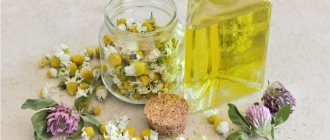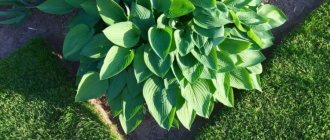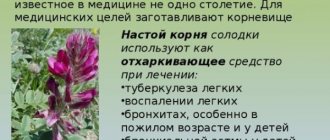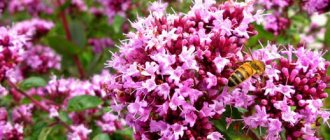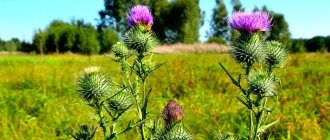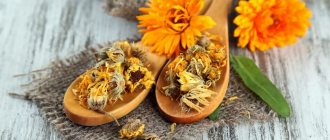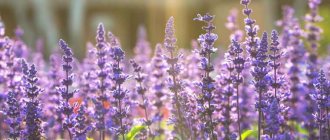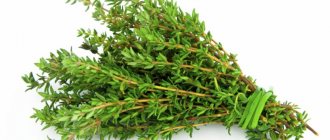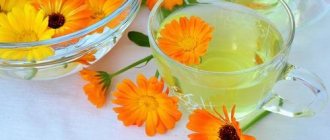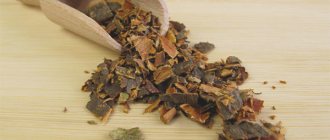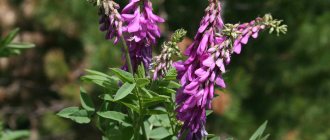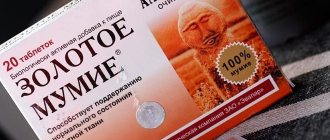The medicinal properties of coltsfoot have been used for a long time. Since ancient times, a decoction of the leaves has been used in medicine and cosmetology (for coughs for children and adults, to support the beauty of skin and hair, to alleviate respiratory diseases).
In the Middle Ages, this plant served as a remedy to help heal abrasions, burns and swelling caused by insect bites.
Interestingly, it has also been used as a tobacco substitute for a long time. Today, the medicinal properties of leaves and flowers help maintain health and strengthen the immune system.
What does the plant help with? Which side should you apply the sheet for swelling and pain in the joints? How to brew individual parts? Does this medicinal herb have contraindications? You will find out the answers to these and many other questions by reading this article.
Compound
The healing properties are due to the combination of active ingredients, thanks to which the herb has a strong antiseptic effect, treats inflammatory diseases and strengthens the immune system.
Flavonoids, tannins, essential oils, minerals, carbohydrates, dietary fiber and acids - this list of main components clearly indicates that all parts of the plant are beneficial. The medicinal properties of the root are little expressed, so it is used extremely rarely in folk medicine.
Composition of active ingredients mother and stepmother.
A complex complex of active substances determines the healing qualities of the plant:
Leaves:
- Bitter glycoside tussilyagin . Reflexively increases the secretion of mucus by the cells of the bronchi, which increases the discharge of sputum from the lungs.
- Saponins are complex organic substances. They are used as drugs that enhance the cleansing of the bronchi from accumulated mucus. These substances remove excess water from the body and have a calming effect on the central nervous system. They exhibit anti-inflammatory effects.
- Carotenoids. Plant pigments synthesized by plants, insoluble in water, are used by the body to further synthesize vitamin A from them.
- Sitosterol . A sample from the group of phytosterols that have the ability to significantly reduce the absorption of cholesterol in the intestine, which allows them to be used as a means of lowering cholesterol levels in the blood.
- Organic acids. The leaves contain gallic, tartaric and malic acid. These components, with weak acidic properties, can affect the cell membrane of cells. Interacting with the protein structures of the cell membranes of microorganisms, skin and mucous membranes of the intestines and stomach, these substances form on their surface a compacted layer of albuminates, which ultimately gives the antiseptic, anti-inflammatory and astringent effect of using such substances.
- Tannins. A group of plant substances showing interaction features similar to the effects of phenols. They tend to form strong bonds with the protein structures of any organic tissues. Used as an antiseptic and astringent for intestinal disorders and to improve the condition of infected wounds.
- Dextrin. A type of soluble polysaccharide. Its fibers can combine with the bile acids present in the lumen of the small intestine, improving their fat-breaking action. Polysaccharides of this type slow down the flow of sugar into the blood (here you can find out: blood sugar test norms) and normalize the presence of lipids.
- Inulin. It has protective and anti-inflammatory properties against the mucous membrane of the digestive system, and also adsorbs toxic substances formed during the digestion of food.
- Slime. Polysaccharides that form thick mucous solutions. Used as an enveloping agent for irritable bowel symptoms.
- Flavonoids. Substances that give color to plant fruits have antibacterial properties. Increases the elasticity of capillary vessel walls, increases blood clotting time.
- Vitamin C. A substance necessary for the functioning of the body. Lack of dietary intake leads to a disease called scurvy. Ascorbic acid increases the body's resistance to infectious diseases.
Flowers:
- Triterpene alcohols. Aromatic hydrocarbon compounds that have a pleasant odor. Their ability to increase the body's resistance to harmful environmental influences has been established. They may exhibit anti-inflammatory effects.
- Bitter glycoside taraxanthin . When taken, it improves the functioning of the stomach and intestines and increases appetite.
- Phytosterol . It can significantly reduce the absorption of cholesterol in the intestine, which makes it possible to use it as a substance that lowers cholesterol levels in the blood.
- Rutin . Quercetin glycoside contains substances with vitamin effects. Eliminates the appearance of defects in capillary walls, increases blood clotting time.
- Essential oils are volatile substances with a unique odor. These plant components exhibit anti-inflammatory effects, have an analgesic effect, and affect the functioning of the heart. In small doses during inhalation they increase the secretory function of the bronchi.
- Tannins. They form stable complexes with protein structures of cells. They are used as antiseptic and astringent preparations for painful intestinal conditions and for washing infected wounds.
Health effects
In addition to its beneficial effects on a weakened immune system, the benefits of coltsfoot include treating skin diseases and supporting digestion.
Positive impact on health.
- Providing relief from respiratory diseases (asthma, bronchitis, cough, cold, flu).
- Beneficial effect on the gastrointestinal tract.
- Elimination of muscle pain.
- Helps reduce swelling caused by insect bites.
- In folk medicine, the herb is also used for phlebitis.
- Headache relief.
- Promoting the healing of wounds, burns, ulcers.
- Elimination of rheumatic pain.
- Regeneration of skin – dry or affected by eczema.
- A decoction as a rinse is recommended for periodontal diseases.
Features of use during pregnancy
Unfortunately, internal remedies based on coltsfoot are not recommended for pregnant women and nursing mothers. The plant contains alkaloids. These substances change the composition of mother's milk and negatively affect the baby's health. Alkaloids can also terminate a pregnancy. They penetrate the placenta and destroy the fetus.
Do not take decoctions based on this plant under any circumstances during pregnancy. Use of coltsfoot herb during pregnancy causes miscarriage or premature birth with a stillborn baby.
Due to serious harm during pregnancy, coltsfoot grass is prohibited for public sale in some countries, such as Germany and Australia. Only in rare cases and under the supervision of a doctor is it permissible to use the plant externally. These points include the treatment of skin blemishes, burns and acne. Pregnant women can also use the herb to strengthen hair and eliminate dandruff.
Application
The medicinal properties of the plant are manifested when used in the form of tea, compresses and inhalations.
Flowers Syrup
- 200 pieces of raw materials;
- 1 liter of water;
- 1 kg sugar;
- 2 lemons.
Article for you:
Beneficial properties of northern linnea and its use in folk medicine
Wash the raw materials, pour boiling water over them and leave them in a bowl overnight. Then strain and squeeze, add sugar and lemon juice. Boil the mixture until thickened. Pour hot into jars and close tightly.
Tea The medicinal properties of tea can hardly be overestimated - it is an excellent cough fighter and is also used externally, as compresses. For cooking we need 2 tsp. coltsfoot. Pour boiling water over it and leave for 10 minutes, then strain. The ideal sweetener is honey.
Internal use:
- colds;
- respiratory diseases;
- bronchial asthma;
- period after pneumonia;
- fever.
External use, in the form of compresses:
- inflammation in the veins;
- external ulcers;
- eczema (also helps with psoriasis);
- poorly healing wounds.
Gargling tea:
- for inflammation in the mouth;
- for inflammation of the throat and tonsils.
Honey
- 200 fresh raw materials;
- 1.5 liters of water;
- 2 lemons.
Pour boiling water over the washed blossoms in the evening, cover with a lid and leave until the next day. Then strain and squeeze. Add sugar, lemon juice and cook until thick. Pour hot honey into jars, close and store in the dark and cool.
Leaves Their beneficial properties and effects are very similar to the effects of flowers, however, the leaves are used mainly externally. Since ancient times, compresses have been made from crushed raw materials on the chest, aimed at supporting the treatment of pulmonary and bronchial diseases.
For rheumatic pain, whole leaves are applied to the affected joints and covered with a scarf or handkerchief (to hold on).
However, in the case of treatment with compresses, you should know which side to apply, i.e. which side is the mother (beneficial), and which side is the stepmother (unfavorable). So, you should apply it on the smooth, green side, which is more pleasant to the touch (well, really, like an affectionate mother...).
External use is suitable for everyone - men, women, children, pregnant and lactating women, as opposed to internal use, which can harm certain categories of people.
Compresses are used in the following cases:
- burns, incl. solar;
- swelling of the joints;
- inflamed veins;
- swelling of various origins;
- poorly healing external ulcers.
- Compress # 1 Remove the stems from fresh raw materials, rinse it thoroughly in cold water, apply 2 layers to the joint. Then secure with a bandage and wrap with a wool scarf for several hours.
- Compress # 2 Grind fresh raw materials so that a porridge-like mixture is formed, which is applied to the affected area and left to act for a long time.
Syrup Place the leaves in a clean glass jar, press down about a centimeter, sprinkle with sugar. Then comes the second layer of compressed leaves and sugar. Continue folding until the jar is full.
Close the jar and place in a dark place, checking from time to time. When the contents change into a dense mass, add 1/2 kg of honey per 1 kg of plant mass and mix thoroughly. It is recommended to take 1 tsp. per day to prevent colds.
Article for you:
Medicinal properties of the herb mallow and its use in folk medicine
Coltsfoot: properties and application. Decoction, infusion, tincture, coltsfoot juice. Photo
PROPERTIES OF COLTSHEPMOTHER
This plant is often confused with dandelion, although it blooms much earlier. Pliny and many ancient botanists considered it leafless, because leaves appeared only after flowering... Many of us recognized coltsfoot from the first words of the description. The pretty flower is one of the first to emerge from the ground in spring, and its wide leaves were sure to surprise everyone at some point: smooth and green on top and velvety and whitish on the back side. In France, the coltsfoot symbolized medicine for a long time; its image adorned all pharmacy signs. And since the seeds of the plant are crowned with a panicle of silky down, in the old days they stuffed mattresses and pillows with them, replacing bird down. Goldfinches to this day cover their nests with coltsfoot seeds.
Description
Coltsfoot (Tussilago farfara) is a hardy perennial plant that grows wild in moist areas, along streams or pastures in loamy and limestone soils. Its peculiarity is that large radial yellow flowers appear much earlier than the leaves, shortly after the snow melts. Later, after they wither, the heart-shaped leaves open. Coltsfoot reaches a maximum height of 30 cm. Its yellow inflorescences rest on thin stems covered with small scaly reddish leaves. The flowers have a pleasant sweet taste. The leaves are shaped like a heart or, as they also say, the footprint of a horse or bull. They are fleshy, with jagged edges, collected in a rosette at the very roots of the plant. When young, the leaves below are covered with whitish fluff. He subsequently disappears. It is because of this cannon that the plant got its name. If you take a young leaf in your hands, the upper side of the leaf will feel cool and hard to the touch, and the lower side will be soft and warm. This contrast evoked in our ancestors associations with the coldness and harshness of the stepmother and the mother’s warmth and softness. The underground stems of coltsfoot remain viable for a very long time. Therefore, it often happens that this plant can appear in places where it did not grow before if the top layer of soil is damaged there. It can often be found in newly formed ravines, pits and near new buildings.
Coltsfoot: properties and treatment
Most often, when it comes to cough treatment, coltsfoot comes to mind. The properties of this plant to thin bronchial mucus and facilitate expectoration have been used since ancient times. Buds, flowers and leaves of coltsfoot have been used in official medicine for centuries to treat dry cough and sore throat. This plant was used by ancient Chinese doctors to treat respiratory diseases, any cough, including asthma, acute and chronic bronchitis. It is one of the components of many European and Russian commercial herbal preparations designed to treat respiratory disorders. This is one of the most popular remedies taken for diseases of the bronchi and lungs. The herb received such recognition due to its ability to remove mucus from the lungs and relieve spasms that increase coughing. In folk medicine, coltsfoot is used as an antipyretic, diaphoretic, appetite enhancer and anti-inflammatory agent. For the treatment of digestive disorders, combating edema and stimulating metabolism, the properties of coltsfoot also turn out to be very useful.
► ORIGIN: PROPERTIES AND APPLICATION
►
DANDELION: PROPERTIES AND APPLICATION
Externally it is used to treat cuts and wounds, insect bites, burns and fight skin infections. In cosmetology, this plant is used to care for hair prone to loss, giving it shine, and stimulating the glands of the scalp.
Coltsfoot: testimony
• Asthma • Bronchitis • Colds • Laryngitis • Flu • Cigarette withdrawal • Dandruff • Burns, cuts • Stomach upset • Insect bites • Whooping cough • Skin infections Uses
Coltsfoot is most often taken in herbal tea or as cough syrup.
Less often in our time, but more often in the old days, smoke from the dried leaves of this plant was used for treatment. Its inhalation was prescribed for those who quit smoking. Externally, coltsfoot is prescribed in the form of tinctures, decoctions or juice. Collection rules
Flowers are picked for drying during the flowering period. Depending on the region, this may be from March to May. Choose a dry sunny day. The inflorescences are cut off from the stems and laid out in an even thin layer on a piece of linen or paper. When drying, the flowers should be protected from the sun, but not deprived of air access. Collecting leaves for harvesting should be done when the whitish fibers have already come off from them, but brown spots have not yet appeared. Typically, coltsfoot has such leaves in the first half of summer. The leaves, like the inflorescences, are dried, spread out in one layer in a shady but warm place. It is desirable that the temperature in the drying area be around 35 - 40 degrees. Properly dried leaves retain their healing properties for three years, and inflorescences for two years. To preserve the beneficial properties of the plant, it should be kept in glass containers, fabric bags or cardboard boxes.
► ORCHIS SPOTTED: APPLICATION
►
ROSE HIP OIL: USEFUL PROPERTIES AND APPLICATION Coltsfoot: contraindications
Due to its potential toxicity, coltsfoot is prohibited for treatment in some countries, as it contains hepatotoxic pyrrolizidine alkaloids.
These are substances that poison the liver and can cause cancer of this organ. Because of these substances, ingestion of coltsfoot should be strictly limited to the period necessary to relieve symptoms of the disease. The maximum duration of taking coltsfoot medications should not exceed six weeks. In addition, you need to remember that if you exceed the recommended dose of products with this plant, it will become not a medicine, but a poison. Coltsfoot is contraindicated for use in the following cases
: Pregnancy and breastfeeding: Products containing coltsfoot can cause birth defects and liver damage.
In addition, there is a high risk of losing a child due to the hepatotoxicity of this plant. When breastfeeding, there is also a very high risk of toxic substances from the coltsfoot passing into breast milk. So it is better to avoid its use during this period. Allergies to ragweed and related plants: Coltsfoot may cause an allergic reaction in people who are allergic to plants in the asteraceae family. These include ragweed, marigolds, chrysanthemums and many others. If you have allergies, be sure to consult your doctor before taking coltsfoot. High blood pressure, heart disease: There is a high possibility that coltsfoot in large quantities may interfere with the treatment of these diseases. Liver disease: Hepatotoxic pyrrolizidine alkaloids may aggravate liver disease. Do not use coltsfoot if you have liver problems. Interactions with drugs
Coltsfoot consumed in large doses increases blood pressure. This property may reduce the effectiveness of medications to lower high blood pressure. Therefore, you should not use coltsfoot with drugs for the treatment of high blood pressure, such as captopril, losartan, diltiazem, hydrochlorothiazide and many others. Some substances formed during the breakdown of coltsfoot in the liver can interact with a number of medications, forming very toxic compounds. Drugs that are strictly unacceptable to use with coltsfoot include medications containing phenobarbital, carbamazepine, rifampicin, phenytoin, rifabutin and a number of others. Medicines that slow blood clotting may interact with coltsfoot. This plant also slows down blood clotting. Thus, as a result of the combination of these drugs with the use of coltsfoot, internal bleeding can be provoked. Such drugs include aspirin, diclofenac (Voltaren), ibuprofen (Nurofen), naproxen, heparin, warfarin.
Practical recommendations for the use of coltsfoot
In folk medicine, coltsfoot is used in the form of tinctures, teas, and decoctions.
In some cases, it is possible to use freshly picked leaves of the plant, or rather, juice or pulp from them. Here are the most common ways to prepare medicines from this herb. Coltsfoot decoction
This recipe can be used both to treat a cough and to solve problems with the stomach or intestines.
Only the dosages differ. To prepare the decoction you will need 2 tablespoons of dry coltsfoot leaves. The finished raw material must be poured with boiling water (1 cup). It is better to do this in a small enamel bowl or saucepan, which then needs to be placed in a water bath and simmered for 15 minutes. After this time, cool the broth, strain through 2 layers of gauze or a wide bandage, squeeze out the remaining raw materials well and add boiled water so that its quantity becomes the same as at the beginning of preparation. That is, you should get exactly a glass of the finished broth. For diseases of the gastrointestinal tract, the decoction is prescribed to drink 100 ml 3 to 4 times a day. If you need to cure a cold, bronchitis or other respiratory disease, the same remedy should be taken 35 - 40 ml in the morning, at lunch and at night. How to make an infusion from coltsfoot
When you don’t have time to use a water bath, you can make an infusion instead of a decoction.
You will need a spoonful of dried coltsfoot leaves and a glass of boiling water. Pour boiled water over the prepared leaves, cover tightly with a lid and leave for half an hour. Next, the infusion needs to be filtered and poured into a glass container. It would be good if it was a bottle or jar made of dark glass. This infusion relieves dry cough and helps cope with hoarseness. Drink it one tablespoon at a time. This must be done three times a day. And so that the product does not spoil ahead of time, it is stored in the refrigerator. True, the shelf life of this infusion does not exceed 2 days. Coltsfoot tincture
The product is prepared with alcohol and can retain its properties much longer than a decoction or infusion. To prepare it, take equal parts of coltsfoot inflorescences and vodka or alcohol. The flowers are poured with alcohol, the container is covered with a lid and hidden in a dark place for one to two weeks. Afterwards, the tincture needs to be strained, and it will be ready for use. Coltsfoot tincture is drunk for colds, hoarse throat, cough, 30-40 drops 15 minutes before meals three times a day.
► TREATMENT WITH ST
. John's wort Juice of coltsfoot
You will need fresh leaves of coltsfoot.
This remedy should not be taken for longer than 10 days. The juice is prepared in early summer. Freshly picked leaves of the plant must be washed well. Then they are rinsed with boiling water and placed in a colander. When most of the water has drained from the leaves, they are passed through a meat grinder. The resulting mass is placed in a container covered with two layers of gauze. After which the gauze with coltsfoot leaves needs to be rolled up and squeezed out properly. If you have a juicer at home, the procedure becomes much simpler - put the leaves in it and squeeze out the juice. Next, you will need to dilute the resulting juice with water of the same volume. Boiling will help preserve the healing drink: 2-3 minutes will be enough. You should drink this juice after meals, one tablespoon at a time. You can prepare coltsfoot juice without boiling, the recipe is the same. The shelf life of this product is very short. Therefore, it is better to make it in small portions immediately before use. Fresh coltsfoot juice is used to treat the so-called “smoker’s bronchitis.” These are severe coughing attacks that occur most often in the morning or after a long period of abstinence from cigarettes. To alleviate these attacks, you need to take a tablespoon of juice and dilute it in a glass of milk. Better than warm. You need to drink it right away, since this medicine is not stored. Gruel from fresh leaves
If you prepared juice from coltsfoot, you can use the pulp that was left over from its preparation. You can also grind the leaves specifically. The pulp from the leaves is used externally. It effectively helps with tumors and skin rashes, herpes zoster. To do this, crushed fresh leaves are applied to the skin, covered with compress paper and wrapped with a warm cloth. The duration of the procedure is 30 minutes. For herpes zoster, such compresses are applied three times a day. No matter how you plan to use coltsfoot, remember that you can harm yourself by self-medicating. Be sure to talk to your doctor before you start taking coltsfoot.
“Site about plants” www.pro-rasteniya.ru
Return to section
If you liked the article, you can share it with your friends on your social network:
| < Previous | Next > |
Breathing problems
Western and Eastern medicine has been using this plant for centuries to treat coughs, emphysema or silicosis. Able to relieve breathing problems - it can cope with asthma, laryngitis and nasal congestion.
Provides assistance to smokers who are unsuccessfully trying to quit a bad habit - grass is the best substitute for nicotine.
People suffering from asthma and having long-term damage to the bronchi and difficulties after smoking will benefit greatly from 2-3 tsp in the spring. freshly squeezed juice added to meat broth or warm milk. By the way, freshly squeezed juice dripped into the ear helps with ear pain.
Do you know how to brew cough tea? Simply mix equal parts of all coltsfoot parts (except the root), mullein flowers and plantain. 2 tsp Pour 1/4 liter of boiling water over this mixture. Sip 3 glasses of hot tea with honey daily.
Botanical description of the species
People can hear a lot of interesting names for this plant - butterbur, mother grass, two-faced grass, podbel, camel grass, water burdock, rannik, icy burdock, king's potion. The biological description of coltsfoot allows you to find out where to find and how to recognize the grass among many other plants. Also read the article: Medicinal chamomile: medicinal properties and contraindications.
Characteristic habitats
Coltsfoot grass is widespread throughout almost all of Eurasia (in particular in the mountains of Asia, Western Europe, Siberia and Kazakhstan), as well as in the vast expanses of North America. You can also see it in northern Africa. It grows well on clayey, fairly moist soils, although it is also found on the sandy banks of many rivers. Most often, grass grows in lowland meadows, slopes of ravines, along the banks of lakes, canals, and rivers. It spreads very quickly and displaces vegetable crops in the fields, which causes a lot of trouble for farmers.
How to recognize coltsfoot?
In our regions, coltsfoot is one of the first to bloom in early spring, when other meadow plants are just beginning to produce young leaves. Its flowers have small bright yellow heads (about 2 cm in diameter) located on a long shoot. Flowering begins at the end of March and continues until May. Heart-shaped, serrated along the edges, coltsfoot leaves grow at the end of the flowering period. They are located on long vegetative shoots, forming a rosette. They are smooth and cool to the touch on top, fleecy and warm on the bottom.
The root system of coltsfoot is highly branched and goes deep into the soil almost 1 m. Fruits in the form of a cylindrical achene with a cap appear in June.
An excellent remedy for fatigue and colds
The content of useful substances in coltsfoot is significant, in all parts except the root. Tannins and vitamin C are present mainly in the leaves. The flowers are rich in other important substances - malic and lactic acid, inulin, choline, mucous substances and zinc.
Tea This medicinal tea can be drunk during flu, colds, weakened immunity, coughs, migraines, inflammatory diseases and other health problems. It is recommended to drink in the morning and evening, both during the acute phase of the disease and as a preventative measure (once a day).
You need:
- 1 tsp dried flowers;
- 250 ml boiling water.
Pour boiling water over the raw materials and leave for 8-11 minutes. Then strain and drink warm. To suppress a specific taste, you can add a spoonful of honey.
Inhalations 1 tbsp. pour 1 liter of boiling water with a heap of crushed raw materials (all parts of the herb) and inhale the steam under a towel. Repeat the procedure several times a day.
Digestive problems
This spring herb can help with diarrhea and slow metabolism. A tincture made from dry raw materials, when taken internally, is used to treat colitis, irritable bowel syndrome, stomach and duodenal ulcers, as well as other problems with the digestive system.
The plant purifies the blood and has a diuretic effect. Due to its excellent antimicrobial properties, it is used to treat cystitis and other urinary tract infections.
Tea 1 tsp. leave with a heap of crushed raw materials (all parts) for 15 minutes in 1/4 liter of boiling water. Drink 1-2 times a day.
Antibacterial action
Coltsfoot has excellent antibacterial properties, literally draws out dirt from all external wounds, incl. resulting from insect bites. The herb contains zinc, which has an anti-inflammatory effect. The high content of mucous substances helps fight dandruff on dry and oily hair. Application is simple: use any tea recipe as a wash and compress.
Preparation of treatment
For greater success in treating various diseases, follow the correct proportions for preparing remedies from the plant.
Herbal infusion
- Dried leaves (7 g) are poured with hot water (275 ml).
- Cook over steam for no more than a quarter of an hour, during which time the broth should be stirred.
- Cool for 45 minutes. Remove excess sediment.
- Add water to the starting volume.
This decoction can be stored in the refrigerator for no more than 2 days. It must be consumed three times, 75-90 ml each.
For a more concentrated decoction, 8 g of raw material must be poured into 220 ml of boiling water. Let simmer for 10 minutes. The decoction can be drunk after a quarter of an hour, 15 ml.
Juice
To obtain high-quality medicinal juice, you should use only fresh June leaves. The herb should be washed and placed in boiling water for a few seconds.
After which the raw materials should be crushed using a meat grinder. Squeeze the juice out of the resulting pulp. It should be diluted with an equal amount of water and boiled for 3 minutes.
The resulting medicine is taken 13 ml three times a day.
Alcohol tincture
In equal parts you should take coltsfoot inflorescences and an alcoholic base. Place the container with the tincture in a dark place for 7 days. Take no more than 40 drops at a time.
Important! Coltsfoot is good at cleansing the blood of toxins.
Depression and immunity
The essential oils contained in the herb help fight depression. Regular consumption of the plant boosts immunity, improves the functioning of lymphatic circulation and helps cure allergies.
Article for you:
Beneficial properties of jarutka herb and its use in folk medicine
Ingredient in Salads If you are a salad lover and are open to new flavors, try using young leaves, cut into thin strips, as an ingredient in salads.
Skin care
Most often, the plant is used to reduce inflammation.
Thanks to its antioxidant properties, it can work wonders on the skin: it helps soothe it and reduce oxidative stress, protects against germs and rejuvenates. Mask This mask is suitable for people with oily skin, acne or other inflammatory skin diseases. It can be used on the face, décolleté and other parts of the body. Avoid the eye area.
Need to:
- 20 fresh coltsfoot (all parts except root);
- mortar.
Grind the raw materials in a mortar to a paste, which you apply to problem areas and leave for 18-22 minutes. Rinse off with warm water and let skin dry naturally.
Hair care This is an excellent assistant in hair care. It is valued for its high content of amino acids, phytosterols and essential oils, due to which it strengthens hair, improves its condition and has a beneficial effect on the scalp, accelerates hair growth, adds strength and shine.
Advice: the plant is not suitable for blondes - it has a slight tint effect and can darken the hair.
Herbal decoction 5 tbsp. herbs, pour 1 liter of boiling water and leave for 20 minutes. Strain and use as a hair rinse.
Side effects and contraindications
The plant is recommended for short-term use only!
The presence of pyrrolizidine alkaloids in the herb does not make it suitable for long-term use (more than 5 weeks). In particular, the root, which, as already mentioned, is rarely used, can be toxic. This is due to the presence of alkaloids, which can have a negative effect on the liver.
For example, in Germany, internal use of the root is prohibited! Can children use coltsfoot? Opinions on this matter differ, some sources indicate the possibility of use in small doses against coughs and external use, others categorically do not recommend the herb for children.
In any case, it is better to avoid its use until the age of 7. It is not suitable for pregnancy and breastfeeding!
Despite the benefits, as can be seen from the above, the plant has some contraindications. Therefore, before using it, it is advisable to consult a specialist!
